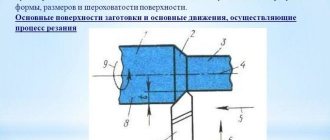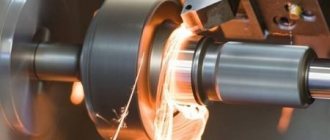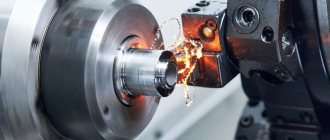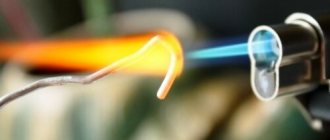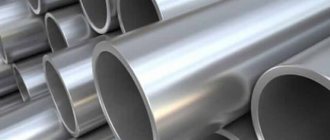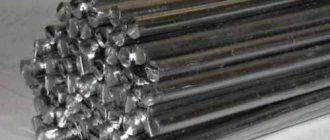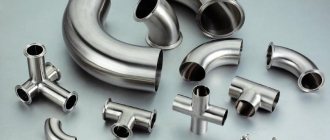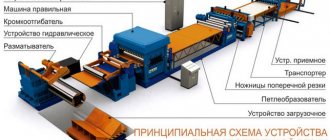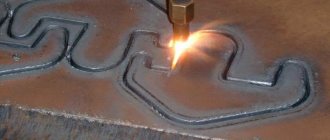Today, throughout the world there is a gradual, smooth technological progress characteristic of all areas of human activity. It was he who made people believe in miracles and make into reality what previously seemed like a wild and impossible fantasy. This phenomenon also applies to such areas as industry, where, nowadays, you can see a full range of lasers, plasma tools, and even devices capable of cutting the toughest materials using water. However, one cannot help but say that their use is completely justified and allows one to achieve high results in a process such as cutting stainless steel, which previously seemed impossible. What is stainless steel? Today, people know special types of steel, one of which is stainless steel. It has a number of advantages over conventional steel, namely:
- high resistance to corrosion processes
- eye-catching appearance
- increased wear resistance
- resistance to high temperatures.
However, in addition to the advantages, there are also a number of difficulties that arise during the cutting process.
The thing is that stainless steel is extremely difficult to cut using conventional methods without damaging its structure or spoiling its brilliant appearance. In this regard, the following began to be actively used cutting stainless steel
- Gas arc cutting
- Plasma cutting
- Laser cutting
- cutting
- Waterjet cutting.
Gas arc cutting of stainless steel.
When talking about types of stainless steel cutting, we cannot ignore gas-arc cutting. This type of processing of a steel sheet is carried out by melting the metal in the place where it is necessary to make a cut. In this case, simultaneously with melting, it is necessary to remove all the resulting oxygen, the presence of which in the metal composition negatively affects the strength. The advantages of this type of stainless steel cutting include the availability of this procedure and its low cost. Alas, there are many more shortcomings that make this process irrelevant. Among them:
- High probability of damage to the metal structure
- Extremely poor quality of side cuts
- Uneven cutting lines.
What products can be cut with a laser?
A fairly large number of products differing in thickness, design, and size are subjected to laser cutting.
First of all, this is sheet material intended for further processing. Stainless steel sheets are pre-fitted to the size of the machine tabletop and checked for uniform thickness. Using a laser, you can perform primary, external decorative or customization processing of a part.
Also, you can cut or adjust finished products in thickness and width. This procedure can help you out if size discrepancies appear on finished parts.
Hydroactive method
Laser cutting and engraving: services, products, materials
The action consists of supplying liquid through a sapphire, diamond or ruby nozzle 1/10 mm wide. The output stream is accelerated to three times the speed of sound, after which the fine, concentrated stream is capable of cutting tough materials, including stainless steel. Pure water is used for soft workpieces; for harder workpieces, abrasive elements (sand) are added.
The speed of modern installations is high, so they successfully compete with laser and plasma devices. For example, Dekart W2040 L reduces up to 8 m of metal per minute (depending on thickness); in the case of stainless steel this figure is usually 2-3 m/min.
Interesting fact: in the West, studies were conducted to determine the effectiveness of waterjet and laser machines. For this, dozens of plates, each 0.3 mm thick, were cut out. It turned out that for bags up to 6 mm thick the laser is more effective, and for bags over 6 mm thick. Hydraulic accumulator.
Advantages of the method:
- Stainless steel does not heat up during operation;
- The likelihood of workpiece deformation is reduced;
- High cutting quality;
- Lowest material losses
- Speed of work;
- Minimal process error (cut width is 10 times thinner than arc cutting).
Flaws:
- High cost of equipment (a conventional waterjet machine will cost the user 3 million rubles or more);
- Rapid wear of working parts.
Cutting stainless steel with a water jet is considered a promising processing method.
Which drill is better to use
- Any tool that contains cobalt in its alloy. The higher the percentage of this component, the better. Cobalt products differ from ordinary ones in a yellowish tint. Do not confuse the cobalt alloy with the application of this metal only to the outer part of the drill by electroplating. In the latter case, it will not be possible to drill through stainless steel.
- Expensive specialized tool. Such pobedit drills can drill through stainless steel, not just concrete. They have a certain sharpening angle.
- For thin stainless steel, you can use a feather-shaped drill bit for ceramic tiles. This is not the best option, but it will help to drill the workpiece once.
Application of cobalt drill
How to drill through stainless steel. Tips for choosing a drill for stainless steel
Of the old Soviet drills for stainless steel, the most suitable tool would be the one with the brand R6M5K5. This type of equipment contains up to 5% cobalt in the alloy. Due to this element, the tool acquires high strength, and the heating temperature can reach 135 degrees Celsius, which does not entail destruction of the material. Products of this quality can only be found in markets where old Soviet equipment is sold, and even then not always. An alternative to a domestically produced cobalt drill is a foreign analogue under the HSS-Co brand.
Selection and operation of two-handed saws
A two-handed saw is one of the most popular and oldest tools for sawing wood. Despite the active development of technology and the production of automatic gasoline analogues, the standard saw never goes out of fashion. The configuration of the device is a flat, C-shaped metal plate, on one side of which cutting teeth are applied. At both ends of the plate there are holes for installing wooden holders - handles. The design of the saw allows for the work of two people, but if necessary, it can be quickly converted into a one-handed tool. Working with a saw is not difficult if you follow basic rules and recommendations.
Laser cutting of stainless steel in Moscow
How to cut gypsum board sheets
The Metal Products to Order organization provides services for profile, decorative and finishing cutting of stainless steel using the most modern and precise technology: laser. The company has been on the market for a long time and has managed to demonstrate itself as a reliable and responsible partner. We carry out laser cutting of stainless steel in Moscow and the Moscow region, as well as in Lyubertsy
The company has at its disposal a large number of machines and equipment designed for processing metals of various types, including a large number of varieties of stainless steel in shape and thickness.
Cutting stainless steel pipes
Oxygen cutting of stainless steel pipes is ordered not only by representatives of state enterprises and companies, but also by private individuals. Stainless steel pipes are in demand not only to achieve production goals, but also to solve economic problems. Stainless steel pipes vary in shape, cross-sectional diameter, and wall thickness. Their labeling, chemical composition, requirements for packaging and transportation are described in GOST 9940 - 81; 9941 – 81; 14162 – 79.
The main purpose of stainless steel pipes is the installation of pipelines for various purposes. In the food and pharmaceutical industries they are valued for their high degree of hygiene; for the chemical and oil and gas industries, their resistance to aggressive environments is important. When choosing a material for installing utility networks, take into account the high degree of resistance to corrosion. Using oxygen cutting, pipes of the required size are obtained that do not have oxides along the edges of the workpiece.
Cutting cast iron with a grinder
Cast iron is a rather fragile metal, but very durable, so it is recommended to use diamond-coated discs for cutting it. You can cut cast iron with simple metal discs, but they are much less durable. You can cut this material with a grinder only in a straight line. Any attempt to make a figured cut can lead to jamming of the cutting wheel. As a result, under heavy loads, the abrasive element is destroyed and its parts flying out at high speed can seriously injure people nearby. But it’s better to cut cast iron with a saw, as in the video:
A grinder for working with metal is the best solution. This versatile tool allows you to use it not only for cutting, but also for polishing, stripping, grinding metal and many other operations.
How to determine when it’s time to sharpen a hacksaw?
How to determine when it's time to sharpen the teeth of the tool.
An experienced owner knows when and how to sharpen a hacksaw, but it is not difficult for the average person to determine this point on their own. As a rule, the sound produced during operation and the uniformity of the color of the cutting edge change.
Sharp cutters are characterized by uniform wear of the cutting edge.
The following signs indicate the need to “correct” the saw:
sawing is difficult and uneven; the cut is uneven; the canvas often gets stuck; It becomes difficult to maintain a given trajectory.
In addition, a dull hacksaw often gets stuck and requires a lot of effort to complete the process.
The main stages of the heating process
To harden stainless steel, it is advisable to know its exact grade, or at least which type of carbon it belongs to (more or less than 0.4%)
This is very important, because in order to properly harden the product, after the hardening itself it must also be released. The brand of factory stainless steel can be found out from the seller of the workpiece, who can also advise on how best to harden it
If some old thing is used as the starting material, then the Internet will come to the rescue with tables of products and grades of steel from which they are made.
In general, the full heat treatment cycle of a stainless steel part includes the following steps:
- Preparation of equipment, tools and materials. This includes checking the fuel (coal or gas), which should be sufficient for the entire heating cycle. After all, in order to qualitatively harden stainless steel, it should be heated smoothly and without interruptions.
- Warming up the forge or stove. If gas-flame heating is used to harden the part, a stainless steel workpiece is installed and the gas burner is turned on.
- Placement of the workpiece. Often it is necessary to harden only some part of the future product, so it should be placed so that this part is in the maximum temperature zone.
- Heating to the required temperature. The product is kept in a high-temperature zone, controlling its heating by color. In order to harden chromium stainless steel, it must be heated to 1050 ºC. This corresponds to a color that is defined in the tables as orange or dark yellow.
- Cooling. After the heated metal has acquired the required color, the part is cooled by immersing it in a container with mineral oil. It can ignite, so keep a piece of thick cloth next to the container.
- Cleaning. After cooling in oil, the stainless steel should be thoroughly cleaned. In case of severe contamination, a solvent can be used.
- Vacation. To harden your part “according to science”, after heating and cooling it should be released. For steels with a carbon content of 0.4% or more, the tempering temperature is 200÷250 ºC (see table below), so it is enough to place them in a regular kitchen oven for a couple of hours. With a lower carbon content, the tempering temperature is much higher, up to 700÷750 ºC, and it is carried out with gradual cooling in air or in dry sand.
Methods for cutting stainless steel
The material in question belongs to alloy types of steel, which are not afraid of contamination and exposure to liquids, since they do not become rusty. The composition of the steel is complemented by a high content of chromium, as well as hardeners - titanium, tungsten, iron molybdenides. Thanks to this, on the one hand, the durability of the metal is achieved by increasing strength; on the other hand, it complicates the cutting process. However, there are several ways to qualitatively divide metal into small pieces.
There are two cutting groups:
- mechanical (the workpiece is cut with a sharp hand tool);
- thermal (due to exposure of the metal to high temperatures, leading to its melting).
The advantage of the first method is that the master will not need expensive equipment. The disadvantage is the need for physical force and a lot of time. Therefore, thermal cutting methods are becoming very popular today.
These include:
- gas arc cutting;
- by electrical erosion;
- waterjet;
- laser;
- plasma.
The features of each type of material processing are discussed below.
Preparation and finishing
The quality of welding of stainless steel, like any other metals, depends on the preparation of the welding zone. The metal must be thoroughly cleaned of grease, dust and dirt, washed with acetone or high-octane gasoline and dried. Use a wire brush to clean the edges of the parts to a characteristic shine.
Welding stainless steel has its own characteristics - a high coefficient of thermal expansion can cause cold cracks to appear if the parts are moved very tightly. It is necessary to leave a small gap between them, the width of which is determined from the reference book or the experience of the welder.
Before cleaning a weld on stainless steel, you must carefully inspect it for cracks or other visible defects. For domestic welding, there is no need to use flaw detection equipment, but for industrial welding, it must be used without fail.
Acid pickling is carried out on all grades of steel using hydrochloric and sulfuric acids. After processing the seam, it is necessary to rinse the work area with clean water. At home, acid etching is rarely done; the mechanical method is more common.
Mechanical processing is carried out by cleaning with a metal brush and processing with fine-grained sandpaper. If possible, sandblast. After mechanical treatment, a passivating solution should be applied to the seam.
Grinding and polishing of the seam area and the entire surface of the product is carried out using polishing and grinding wheels with various types of surface. The tools used are a grinder or vibrating sanders.
Mechanical methods
- Bulgarian. A working method, but the stainless steel should not heat up. To do this, water the cut area. An increase in disk life will also be achieved.
- Metal scissors. The method is only suitable for very thin stainless steel sheets (0.5-1 mm).
- Circular saw for metal. Instead of a toothed disk, a cutting abrasive disk is installed (as on an angle grinder), and some kind of stop is placed on the sheet to be cut. The downside is the impressive consumption of the wheel, and if the adjustment is incorrect, the workpiece is pulled to the side and the cut is disrupted.
Treated stainless steel sheets can be bent, stamped, polished, painted, welded, etc. There are many ways to divide large workpieces into small ones, and it is up to you to decide which one is more effective. The best option for home use is an angle grinder; for industrial use, cutting stainless steel with a laser or plasma is acceptable.
If you know other ways to process alloy steel or notice an inaccuracy in the description, please share the information with readers.
How does the stainless steel cutting process work?
Laser cutting of stainless steel is a complex technological process that requires a correct, and most importantly, structured approach. The cutting process begins with drawing up a drawing, first in paper form, then in computerized
When modeling cuts and slits, it is important to consider the cutting thickness: the width of the light beam coming from the laser. Also, do not forget the possibility of adjusting this parameter: the narrower the spot, the faster the metal will be cut.
Even at the modeling stage, it is necessary to take into account the maximum cutting area of the equipment used: all CNC machines have a strict size limit, and it is simply impossible to cut a part that is not included in this range.
Then the finished file is sent to the main operator of the machine: depending on the goals set, he configures the equipment according to ready-made instructions and puts the CNC into operating mode.
Depending on the thickness of the material being processed, the laser output power is adjusted. At the same time, the cutting speed must be maintained: otherwise, the laser may not have time to make a cut in the required place.
How to sharpen?
The process of sharpening a two-handed saw is carried out in the same way as in the case of an ordinary hacksaw for wood. Only with this tool everything happens much easier due to the large cutting teeth, you just need to prepare correctly. For self-sharpening you will need:
- rectangular file;
- template for precise setting of teeth;
- homemade wooden vice.
Since the blade of a two-handed saw is long, it cannot be clamped in an ordinary metal vice. You will need to design this device yourself. To do this, you need to fasten the saw blade lengthwise between two boards, tie them tightly at the edges with a rope and install the resulting structure on legs. Then you should make sure that there are no protruding elements among the teeth; they should all have the same height. If any tooth rises above the rest, you need to shorten its top with a file. It is important to maintain the length of the tooth relative to the base, so after grinding off the upper part, you need to make a corresponding cut deep into the blade.
When sharpening, it is recommended to attach the file to a wooden block to avoid damaging your hands, and to carry out all work while wearing construction gloves. When the height of all the teeth is adjusted, you can proceed to setting them - bending the teeth in different directions one by one (one to the left, one to the right). This will increase the width of the future cut and make the work easier.
The teeth should be moved apart at a distance of no more than 2-3 mm relative to the plane of the tool. In order not to make a mistake with the angle of bending of each tooth, you can use a template; you can buy it or make it yourself.
The template is a wooden or metal strip bent at a certain angle. Its flat base is applied to the saw blade, and the curved top determines the angle of the teeth.
How to saw ❓ WITH A HACKSAW for metal
After wiring, they begin directly to sharpening the cutting elements. To do this, a file is brought to the edge of each tooth and, using reciprocating movements, its edge is sharpened, like an ordinary kitchen knife. It is advisable to move the file away from you, this will create a sharper angle. When sharpening, you need to firmly press the surface of the file against the edge of the tooth; you cannot perform this action in a sweeping manner. Otherwise, the file may slip, which can result in serious hand injuries.
Having sharpened the edges on one side, you need to move to the other side and process the second edge of each tooth in the same way. It is important to note that when purchasing a new tool, the width of the cutting edges on the teeth is different - one is narrower, the other is wider. Narrow edges only separate the fibers of the wood material, while wide ones cut them, which ensures fast and accurate cutting along the intended cutting line. It is advisable to maintain these proportions during sharpening so as not to reduce the effectiveness of the tool.
READ How to Cut Plexiglas at Home
Circular cutting for stainless steel
The methods listed above are unlikely to be suitable for a person with ordinary needs and a small amount of work with stainless steel. Returning to the beginning of the article, we come to the conclusion that it is advisable to use angle grinders (popularly called “grinders”) for cutting the capricious alloy. There are certain subtleties and little things that can carry out cutting at a level no worse than the factory one. To do this, use a special cutting wheel for stainless steel
.
Its main difference from a regular circle is the structural differences that contribute to additional heat removal from the cutting site. In addition to this factor, a component component is added. The grains and abrasives are selected so that stainless steel discs
can cope with a more durable and mechanically resistant anti-corrosion alloy.
Many of the wheel manufacturers provide a large niche in their own product line for stainless steel wheels and steel blades for circular saws
. Among the most famous are Luga Abrasive, 3M, Metabo, Cibo, Klingspor, Hilti and a number of others. Comparative tests of these cutting tools are carried out using a standard procedure for cutting a sheet of stainless steel metal, 3 mm thick. Using the same angle grinder, measure the width of the cut (to analyze the lateral runout) and the remaining diameter of the circle after a series of cuts. By linking the results obtained to the weighted average price of a particular circle on the market and in the store, everyone will decide on the choice of a suitable product to achieve their intended goals.
There are many “test drives” of cutting wheels for stainless steel posted on the World Wide Web. As a rule, their analysis indicates a direct dependence of quality on the price of the product. A good product will not be sold cheap. Thus, Cibo Top, Hilti Universal Premium, Bosch Expert, well-known wheels on the market, occupy high places in test ratings, showing twice the performance with a price priority of no more than 20-30% compared to competitors. By adding less disc runout, you can reduce the costs of subsequent operations to fine-tune the cut to an ideal state.
The best way to cut stainless steel
Today, throughout the world there is a gradual, smooth technological progress characteristic of all areas of human activity. It was he who made people believe in miracles and make into reality what previously seemed like a wild and impossible fantasy.
This phenomenon also applies to such areas as industry, where, nowadays, you can see a full range of lasers, plasma tools, and even devices capable of cutting the toughest materials using water.
However, one cannot help but say that their use is completely justified and allows one to achieve high results in a process such as cutting stainless steel, which previously seemed impossible.
What is stainless steel? Today, people know special types of steel, one of which is stainless steel. It has a number of advantages over conventional steel, namely:
High resistance to corrosion processes Attractive appearance Increased wear resistance Resistance to high temperatures.
However, in addition to the advantages, there are also a number of difficulties that arise during the cutting process.
The thing is that stainless steel is extremely difficult to cut using conventional methods without damaging its structure or spoiling its brilliant appearance. In this regard, the following began to be actively used for cutting stainless steel:
- Gas arc cutting
- Plasma cutting
- Laser cutting
- cutting
- Waterjet cutting.
Gas arc cutting of stainless steel
When talking about types of stainless steel cutting, we cannot ignore gas-arc cutting. This type of processing of a steel sheet is carried out by melting the metal in the place where it is necessary to make a cut.
In this case, simultaneously with melting, it is necessary to remove all the resulting oxygen, the presence of which in the metal composition negatively affects the strength. The advantages of this type of stainless steel cutting include the availability of this procedure and its low cost.
Alas, there are many more shortcomings that make this process irrelevant.
Among them:
- High probability of damage to the metal structure
- Extremely poor quality of side cuts
- Uneven cutting lines.
Plasma cutting
In order to achieve better results than in the first case, it is necessary to use plasma cutting. This type of cutting is based on the use of tungsten electrodes, which form plasma based on high-temperature gases.
Plasma cutting, due to its high temperatures, has a high penetrating ability, cutting through layers of stainless steel and removing from there all the by-products that have accumulated during the cutting process.
Perhaps the disadvantages of such processing of stainless steel include the impossibility of cutting layers of metal with a thickness exceeding the 30 mm mark, as well as the need for subsequent mechanical processing of the edges to give them the desired appearance.
Laser cutting stainless steel
Another, no less interesting type of cutting is laser, which is the most advanced processing technology among all available to mankind. It is the laser beam, consisting of highly concentrated particles, that is capable of cutting stainless steel with extreme precision, but at extremely low speed.
Stainless steel cutting
The least interesting of all the above types of cutting is stainless steel cutting. This process is the processing of a sheet of metal through directed mechanical action. It is used only in exceptional cases, to obtain parts of simple shape and small thickness.
Waterjet cutting
Last on the list, but far from least important, is waterjet cutting of stainless metals. From the name it is already clear that the metal is exposed to concentrated water flows, which contain an abrasive solution. Thus, with a jet speed of 1000 meters per second, it is possible to cut any sheet of steel up to 100 mm thick in record time.
Despite these significant advantages, even waterjet cutting is not perfect. The only drawback that repels customers and significantly hinders the development of this technology is the high price for this type of service.
To summarize, by choosing the most suitable processing method in a given situation, you can achieve the desired results without going beyond your budget and time constraints!
How to cut metal with a hacksaw ⚙️ Introductory course
The general theory of sawing with a hacksaw looks something like this:
The theory of sawing with a hacksaw. Introductory course
Therefore, we will not study theory, but will go straight to practice:
In this video, the entire story about how to saw is, in fact, presented, but now there will be a postscript, a number of additions and amendments will be presented (plus a brief retelling of the content of the video).
So, let's start with the fact that you need to cut metal horizontally with a hacksaw, grasping the tool with both hands. Why it would be good to use a hacksaw with a well-defined handle for gripping with the second hand.
Sawing horizontally is inconvenient because it requires the workpiece to be secured at chest level, and sawing while standing. However, workbenches, as a rule, are tables at which you need to sit, and if you saw , then stand and from top to bottom. Therefore, hacksaws are often made one-handed and sawed at an angle of 45°.
To regulate the pressure on the saw (the harder the metal , the more you need to load the blade, put pressure on it so that the teeth bite into the flesh; and vice versa - if the teeth cut too hard, for example, into aluminum, then you need to reduce the pressure) you can: a) change angle of inclination when sawing, b) put your hand on top to increase the weight, c) turn the blade with the teeth back.
The saw often gets stuck in the cut when reaching the end of the blade. This is due to the fact that the blade has a wavy set of teeth (so that the cut is wider than the blade and it does not get stuck in the cut), but over time, the amplitude of this wave decreases in the center of the blade, and almost none at the ends.
The teeth grind down more in the center of the blade
This distortion arose due to sawing with this blade not of its entire length. It is no longer possible to correct this (increase the spread in the center or decrease it at the ends) due to the fact that the teeth are hardened. So the moral is: from the very beginning of using a new blade, you should always saw along its entire length.
Next problem: if you cut a thin sheet of metal, the thickness of which is less than the distance between the teeth, the saw gets stuck:
A part that is too thin gets stuck between the teeth
If the metal is hard (iron), you can barely move it, but if it is soft (aluminium), a huge piece of metal is torn out, torn edges are formed, and the edge bends.
We saw a thin part at a strong angle
Saw at an angle to form a cut of such length that at least two teeth lie on it at the same time (cut length ≥ two distances between teeth).
Next topic: sawing a thin-walled aluminum pipe:
Pipe twist direction
We install the blade with the teeth backwards, twist the pipe in the direction of the teeth (otherwise the blade will get stuck on the near edge of the cut, and if force is used, it will tear).
Well, and even before the heap... the blade of a hacksaw for metal can be restored, the teeth can be sharpened, for example, like this:
Initially, this diamond disk was larger in diameter and this drill with this disk, being pressed in this way to the blade, was positioned strictly parallel to the mowing line of the teeth of the blade, and the disk, accordingly, was perpendicular. And this was correct - the front edges of the teeth on the new hacksaw are orthogonal to the blade. Now a small negative angle is formed... - a little less better, but still normal.
Another note: this blade can be drilled with a regular metal drill (made of HSS steel). Because in production the entire blade is not hardened very much, for elasticity, but the teeth are hardened separately by induction heating with rapid cooling for hardness, so with these teeth you can safely saw the drill in reverse.
How does a laser cut stainless steel?
First, a little about the process itself. We won’t go into technical details - this is not a textbook for carvers, but a review article for customers.
How can intangible light cut through solid metal? It's a matter of heating. The concentrated laser beam heats the area it is aimed at to extreme temperatures. Most laser systems melt metal. Some don’t just melt, but evaporate. This is a huge temperature, as you understand.
But in principle, for work it is enough that the metal is simply melted. A powerful gas jet directed into the cutting zone blows out the resulting melt, leaving a smooth edge. Plus, the gas jet cools the cut
It is important. Thanks to this, parts that have undergone laser cutting do not have thermal deformations - all the melting energy is concentrated in the right place, and the rest of the part heats up weakly
At the same time, to cut stainless steel, just air is not enough - in a good way, you need nitrogen. Nitrogen displaces oxygen from the cutting zone, which could participate in a thermal reaction and spoil the metal.
The point is this. Now let's look at the types of tasks for which you should NOT use laser cutting.
Height alignment
After the setting has been completed, the hacksaw needs to be checked to ensure the same height of the teeth. Since the force may have been applied unevenly, there is a chance that teeth with less wear will appear that will protrude above the rest.
To identify such teeth on a hacksaw, you can use a simple method. It will require thick paper or cardboard along the length of the cutting blade. The sheet should be placed on a flat surface, such as a table, leveled well, and then the cutting part of the sheet should be pressed against it with force. Teeth that are out of alignment will make deeper indentations on the surface.
Thanks to this, they can be easily detected and corrected before sharpening begins. To remove excess height, various needle files are used. While performing this work, you should strive to preserve the shape of each hacksaw tooth as much as possible.
Coolants and lubricants
For drilling holes in stainless steel, there are more effective lubricating solutions that can be prepared at home. This applies, for example, to a solution based on sulfur and fatty acids. Cooking method:
- Laundry soap is ground by rubbing on a medium grater.
- The resulting material is dissolved in a container with hot water until it becomes a saturated soap composition.
- Take technical hydrochloric acid and slowly pour it into the same container. As a result of the chemical reaction, fatty acids will rise to the upper layers of the solution.
- After the process is completed, cold water is poured in to solidify the fatty acids, then they are mechanically separated from the total mass.
- Sulfur and lubricant are mixed in a ratio of 1:6.
At home
In order to answer the question: how to weld stainless steel at home, you should familiarize yourself with the following information.
For beginners and home welders, the best option for welding work is electric welding using an inverter. A welding machine of this type has a compact size and operates from a standard 220 V power source.
In addition to the apparatus, the performer will need electrodes: special for stainless steel or regular ones. Welding is carried out on a thoroughly cleaned surface. The connection is made with direct current, the value depends on the thickness of the metal and varies from 40-150 A.
Video
The video popularly explains how to do this.
Let us repeat, to select brands of stainless steel electrodes, go to the appropriate section. Questions about welding thin stainless steel, pipes, and black steel are discussed here.
All of the above methods will help you understand what you can use to cook stainless steel in each specific situation. Depending on the grade of corrosion-resistant steel, the contractor selects the optimal welding mode. The correct parameters guarantee the safety of the welding process for the performer and ensure the required quality of the weld.
Each welder will decide for himself what is the best way to weld stainless steel after reading the listed data.
What are the advantages of laser cutting of stainless steel?
In other cases, when it comes to working with stainless steel sheets of moderate thickness, laser cutting has serious advantages over competing technologies - chopping and plasma cutting.
Exact match to the project
Firstly, the laser is aimed with an accuracy of tenths of a millimeter
For cutting roofing sheets, it doesn’t matter. But for instrument making it’s a must
Here the laser outperforms cutting and plasma - both of these technologies provide less accuracy.
Secondly, the laser consistently produces the same contour from cut to cut. Every detail will strictly correspond to the laid down program. Coordinate punching machines, in principle, are just as stable, albeit with less accuracy - but a plasma arc, for example, is unstable and allows fluctuations.
Laser produces high-quality edges
Again - perhaps this would not be important for roofing sheets
But for delicate and precise work it is important. The only drawback to laser cutting edges is a slight taper when working with thick steel.
In the range of several millimeters - that is, at the most popular thicknesses - this taper does not appear at all. When cutting stainless steel 10 millimeters thick, it may already appear. The slope of the edges will be around 0.5 degrees, the hole will widen slightly towards the bottom. Strictly speaking, it is impossible to notice this with the naked eye, and it will not affect most operations with this hole. However, it is worth keeping this in mind.
Chopping gives rough edges - that's what chopping is for. Plasma too: burns, scale. Plus taper - but this time with expansion upward and much more noticeable - from 3 to 10 degrees. That is, even with a metal thickness of 20 millimeters, the difference between the upper and lower diameter of the hole can reach up to 1 millimeter.
Here's what we offer:
Production of parts for medical equipment
Minimum human factor - minimum defects
Laser cutting machines use numerical control. The laser beam moves clearly along a given path and at a given speed. If the initial calculations are made correctly, the processing will be of equal quality along the entire length of the cut. Regardless of how many parts are in the batch, the robot never gets distracted or sneezes. Therefore, the cut is always the same, and there are no defects at the cutting stage.
Fine cuts and complex contours available
The laser can make thin holes—thinner than other cutting methods. With a plasma arc, for example, you can cut a hole with a diameter of at least 4 millimeters, and even wider for thick steel. The laser cuts holes equal to the thickness of the metal, from 1 millimeter.
Plus, for complex shapes, the laser clearly cuts corners without rounding them, like plasma.
No scratches or thermal deformation
There is no physical impact on the workpiece, and the thermal impact occurs in a minimal area - in fact, in the cutting zone. For comparison, when working with coordinate punching machines, the part must be rigidly fixed - hence the scratches. And the plasma heats up the entire workpiece, leaving thermal deformations.
Quick launch into production
This advantage is typical for both laser and plasma. A jig punch machine may have problems with this if the part has holes that differ from the standard ones. In this case, you will have to produce punches specifically for it.
To start the laser and plasma operation, it is enough to create a cutting program and start the machine.
And here is an example of a case produced by Metal-Case:
Body frame made of rectangular stainless steel pipes
The laser has a thin cut, unlike plasma. Accordingly, it is often possible to cut more parts from one sheet of metal with a laser. In small batches this may not seem serious - but in large batches it turns out to be an important advantage.
Pereosnastka.ru
Cutting round material and pipes with a hacksaw
Cutting round material and pipes with a hacksaw
Cutting round material. A hand hacksaw can be used to cut round material with a diameter of up to 100-115 mm. In plumbing practice, manual cutting of metals with a diameter of only up to 70 mm is allowed; metal of larger diameters is transferred to cutting machines for cutting; Only in exceptional cases should round material with a diameter greater than 70 mm be cut with a hand hacksaw.
Let's look at the techniques for cutting round metal.
Suppose you are asked to cut a workpiece 100 mm long from a steel bar with a diameter of 40 mm.
This work is performed as follows: 1) mark the required length on the bar and mark it with a scriber; 2) clamp the bar horizontally in a vice, releasing the cut end away from the jaws of the vice so that during operation the hacksaw heads do not touch the side of the vice; 3) with a triangular file at risk, make a small cut so that the hacksaw blade does not slide along the surface of the rod when cutting; 4) pick up a hacksaw, stand in the correct working position in front of the vice, insert the hacksaw blade with its teeth into the cut and begin cutting;
5) when the cutting comes to an end, support the cut piece with your hand so that it does not break off.
If, when cutting workpieces, it is not necessary to obtain clean ends, it is permissible, in order to save time, to cut the metal from several sides, not reaching the middle, and then break off the workpiece (Fig. 1, a, b). You cannot break a workpiece with a one-sided cut: in this case, the breaking line will necessarily deviate to the side from the cutting line of the cut (Fig. 1, c). Thin steel bars cut in a circle are broken by hand, clamping the bars in a vice.
Thick steel rods, after being cut with a hacksaw on two opposite sides, are broken with blows of a sledgehammer through a metal spacer-bar, as shown in Fig. 1, d.
Pipe cutting. First of all, a hacksaw blade with fine teeth is selected, then a template is made from thin sheet metal in the form of a rectangular plate bent along a pipe. After this, the required length of the workpiece is measured from the end of the pipe and a mark is made, then the template is brought to the mark and a mark is drawn along the edge of the template on the circumference of the pipe.
To cut the pipe, the pipe is clamped in a vice in a horizontal position. At the same time, you need to be careful not to crush it. Thin-walled pipes with a clean surface should be clamped in a vice between special wooden jaws
Cut a ton of rails with a hacksaw at any cost. (Part 1) #Dig #scrap metal.
When cutting a pipe, you need to hold the hacksaw horizontally, but as the hacksaw blade deepens into the pipe, slightly tilt it towards you. Every time the hacksaw begins to get stuck in the cut and cutting becomes difficult, remove the hacksaw from the cut, turn the pipe 45-90° away from you and continue working. When cutting pipes, the hacksaw moves at a speed of 35-45 strokes per minute with very light pressure on the blade. You must always ensure that the hacksaw blade does not deviate away from the line.
To cut pipes, pipe cutters are also used, in which steel discs serve as cutting tools. Medium-diameter pipes are cut with pipe cutters with one and three cutting discs.
In Fig. Figure 1 shows a pipe cutter with three cutting discs, which is more convenient to use than a single-disc one. When working with a single-disc pipe cutter, the mechanic is forced to make swinging movements with his hand (back and forth) and at the same time periodically describe a full circle around the pipe with the handle. When a three-disc pipe cutter is used, cutting the pipe in three places at the same time, the mechanic only has to make pumping movements.
Large diameter pipes are cut with a chain pipe cutter or
pipe cutter with clamp. These pipe cutters are multi-disc, and they work by swinging the handle with a small swing.
When cutting pipes with a pipe cutter, a special pipe clamp is used - a device consisting of a frame with a hinged upper part, in which a cracker with ledges is placed that allows clamping pipes of various diameters.
Holding the pipe in a clamp, put a pipe cutter on it, then move the movable disk of the pipe cutter until it comes into contact with the wall of the pipe and tighten the screw of the disk one A turn. Having done this, they begin to rotate the pipe cutter by the handle around the pipe or turn it up and down, tightening the screw of the movable disk after each turn.
The rotation or swing of the pipe cutter around the pipe continues until its walls are completely cut. The cut area must be lubricated with oil or emulsion to prevent the discs from heating up. During operation, do not tilt the handle of the pipe cutter to the sides. If you still get some distortion, you should not try to straighten the pipe cutter: this will only lead to damage to the discs.
The skewed edge of the pipe is straightened by filing with a file.
What are the limitations of laser cutting stainless steel?
Maximum thickness of stainless steel for laser cutting
Lasers cut thin sheet metal efficiently and cheaply.
- Of course, not as cheap as guillotine cutting - but guillotine cutting does not allow for fine work and produces mediocre edges of parts that require additional processing.
- However, it is quite comparable to plasma cutting, the second competing technology.
As the thickness of the metal increases, the cost of laser cutting increases. However, like the cost of any other type of cutting. The question here is the dynamics of this increase. As the thickness of the sheet increases, there comes a time when a high-quality cut requires too much energy - and it simply becomes unprofitable.
- With a sheet thickness of up to 20 millimeters, the use of a laser is justified - not much energy is required, the laser is relatively cheap.
- From 20 to 40 millimeters, laser use is no longer recommended. Plasma cutting will be more profitable. But plasma has less accuracy, produces shape deviations from part to part - and also has a relatively low quality of edges compared to laser. And if accuracy and quality are fundamental for a specific order, choosing a laser within this range of thicknesses is still possible.
- But with a thickness above 40 millimeters, even high quality does not justify the increase in the price of laser cutting. It will be cheaper to cut with plasma and mechanically process all the edges whose quality you are not satisfied with.
In fact, most of the orders for laser cutting of stainless steel in instrument making are not even 20 millimeters, but 10 – and then with a margin. However, in principle, this property of the laser is worth keeping in mind.
Flat cutting VS volumetric cutting
Important point. For obvious reasons, it is easy for a laser to cope with sheet metal - the cutting head moves above it along two axes X and Y, deviations from the vertical are possible, but are generally not used. Volumetric laser cutting is more difficult.
Until recently, it was practically impossible on an industrial scale - there were no suitable lasers. Now there are lasers built on fiber technology. Some machines based on it can perform volumetric cutting, cutting off unnecessary things from the metal “blank”. However, this method is still rare.
So now laser cutting is actively used only in sheet metal production. Then these flat developments can be folded into housings on bending machines and welded - this is not a problem. However, not every part can be made in this way. So complex volumetric parts, as before, are manufactured:
- or by casting method,
- or on milling machines.
Yes, of course - casting takes a long time to put into production, and milling produces a fierce, frantic consumption of metal. We can expect that 3D laser cutting machines will become more common in the future and will replace milling. But for now the situation is as follows, and volumetric parts are the main limitation when laser cutting stainless steel.
Design features of the file
This two-person tool is also called a crosscut saw, which belongs to the category of hand-held devices and is used primarily for sawing wood materials of various sizes and thicknesses. For this purpose, the saw has different lengths of blades - from one meter to two. It is inconvenient for one person to hold such a long blade, so the design of the device has two handles. Not only in Soviet times, but even today, the production of two-handed hacksaws continues in compliance with standard sizes:
- 1 meter or 1000 mm
- 1.25 meters or 1250 mm
- 1.5 meters or 1500 mm
- 1.75 meters or 1750 mm
The blade does not have a straight shape, but a rounded one, which is made specifically to increase the efficiency of sawing, as well as reduce the load. The teeth on the blades are large compared to hand saws, and their size is 20 mm. Even if you use a meter-long file, it is inconvenient to work with it yourself. There are several reasons for this:
- The large length does not allow the sawyer to make a strong swing
- Large saw teeth are difficult to bite into wood, and therefore the sawyer alone cannot cope with actuating the cutting device
- Strong vibration increases the load, as well as reduces the efficiency of the actions performed.
How to cut metal with a hacksaw. 21st century in the yard
Saws with blades of 1000 and 1250 mm are popular due to the fact that they have a simplified design. Hacksaws with blades of 1500 and 1750 mm were used primarily in industry for sawing construction and wood materials. If they are found in the household, they are exclusively saws with blades of 1 m and 1.25 m. They have classic triangular links, the sharpening angle of which varies from 35 to 70 degrees.
- To cut dry and frozen logs, it is recommended to use a cross-cut saw with a tooth sharpening angle of 50-70 degrees.
- For sawing soft wood, a tool with sharpened links at an angle of 35-40 degrees is used.
Two-handed saws with blades from 1.5 meters have a complex design, which simplifies the use of a large unit. Special sharpening and shape of the teeth on large saw blades are needed to perform high-quality and fast cutting of wood material. The principle of sawing with a hacksaw with a long blade (1.5-1.75 m) differs from the operation of saws with 1 m and 1.25 m in that half of the teeth are responsible for cutting through the fibers, and the second part contributes to the rapid and efficient removal of chips from under the cut site.
This is interesting! If ordinary hacksaws for wood and two-handed saws up to 1.25 meters long can be sharpened independently, then a hacksaw with a blade of more than 1.5 meters, which has a complex tooth shape, can only be sharpened by specialists with extensive experience and experience.
If you come across a saw with a complex tooth shape, do not rush to sharpen it at home. If you do not take into account the difference of fractions of millimeters in the complex design of the teeth, then an attempt to restore integrity will lead to complete damage to the two-handed saw. The consequences will be approximately as follows:
- If the difference in the ratio of angles between the cutting and clearing teeth is reduced to one value, then instead of sawing, the blade will tear the wood and only complicate the physical work of sawyers
- If the difference in the ratio of the teeth is large, then the chips will not be effectively removed from the cut, which will also complicate the work
That is why sharpening a crosscut saw requires an appropriate and competent approach. The principle of sharpening a two-handed saw from 1 m to 1.25 m is similar to the process of sharpening the teeth of hand saws.
Stanley 1 15 122
A model from a well-known brand that belongs to the budget segment. For this money, the buyer receives a working tool for home use with a blade length of 300 mm. The Stanley 1 15 122 metal hacksaw
Gross 77604 – locking lever allows you to achieve maximum blade tensionStanley 1 15 122
Gross 77604
Another inexpensive model, the cost of which is 1,453 rubles. hacksaw is equipped with a steel frame with a varnish coating to prevent corrosion. Additionally, to achieve maximum tension, a special lever mechanism is used. It is possible to rotate the bimetallic blade by 45º and 90º. The handle has a rubberized insert.
Bison PRO-900 is an almost complete copy of the product from Gross
Separately, it should be noted the price of blades for a hand hacksaw for metal. It varies from 8 to 1500 rubles per piece. The main pricing factor in this case is the quality of the material used, the number of teeth, the sharpness of their sharpening and the brand.
Bahco 325
A professional model, which is equipped with a durable aluminum frame with a convenient spring tension mechanism. This allows you to quickly replace it. The basis of this tool is a bimetallic hacksaw blade 300 mm long. High hardness ensures maintaining a sharp edge. The angle of change of the blade inclination is 55º. Users consider the only drawback to be the high cost, which is 3,062 rubles.
Stanley 1 15 122 – budget option for home useBahco 325
Production cutting methods
The components of stainless steel give it advantages over unalloyed or low-alloy steels. But they, at the same time, serve as a reason for the loss in some design features. This applies to cutting and cutting metal. Ferrous metal can be cut in a garage using an ordinary grinder or metal saw.
It is somewhat difficult to do the same with stainless steel. The likelihood of changing the structure and damaging the decorative surface remains at a high level and depends on what you use
to cut stainless steel
. In production, the following methods are used for cutting this type of sheet:
- Cutting and cutting using GDA (gas arc cutting apparatus)
- + availability of the method;
- + low cost of equipment and the process itself;
- - poor quality and unevenness along the edge of the seam - additional processing;
- — risk of changes in the metal structure.
- Application of plasma cutting of metal
- + high speed of the process;
- + removal of slag and harmful phases from the cutting area;
- — available thickness no more than 30 mm;
- — subsequent mechanical processing.
- Cutting on a laser radiation installation
- + high accuracy;
- + the coefficient of material utilization during cutting tends to 1;
- + absence of transformations in the structure;
- + no need for additional processing;
- — high cost of equipment;
- — the need for highly qualified personnel.
- Metal cutting.
- + low cost of the process, does not require additional investments and costs;
- - is rather an exception for stainless steels, used for one-time work and parts of a non-critical group.
- Waterjet cutting.
- + cutting speed can reach 1 km/sec;
- + the shape and spatial orientation of the cut is not limited;
- — high cost of equipment, its maintenance and depreciation.
How much does a plasma cutter cost?
Plasma cutters
| Cutting thickness | Voltage | Price |
| 60 mm | 380 V | In stock: Little211,000 rub. |
| Promotion! Aurora PRO AIRFORCE 100M Free shipping | ||
| 40 mm | 380 V | In stock: Many RUB 96,700 Cashback: RUB 4,835 |
| Aurora Jet 40 Free shipping | ||
Interesting materials:
Why can you plant onions? What is the best way to plant garlic? What is the best way to insulate seedlings for the winter? How to treat the roots of seedlings before planting? How to treat strawberry seedlings before planting? How to feed a young grape seedling? How to feed young rose seedlings? How to feed young grape seedlings? How to feed an apple tree seedling when planting? How to feed strawberry seedlings?
